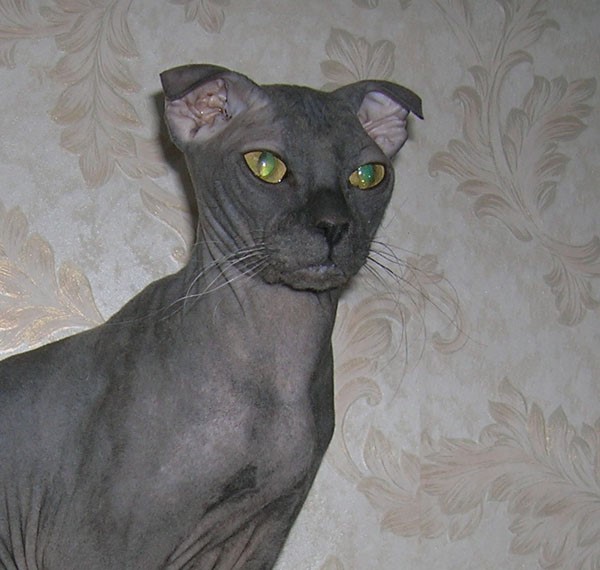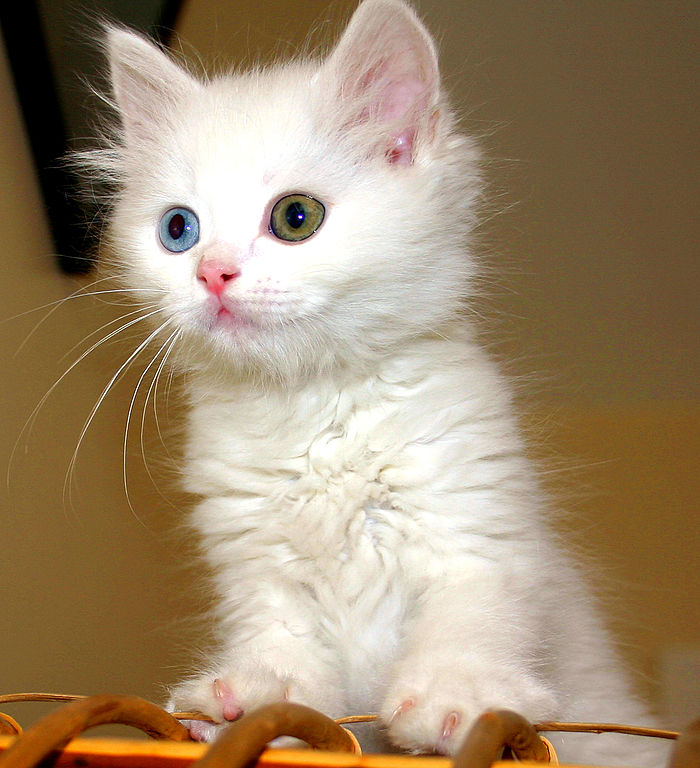
Eine Übersicht über die Keywords zum Verkehr. Hier können Sie leicht nach Schlüsselwörtern und Definitionen suchen, die Sie noch nicht kennen.
More subjects
The Turkish Angora (Turkish: Ankara kedisi, 'Ankara cat') is a breed of domestic cat. Turkish Angoras are one of the ancient, natural breeds of cat, having originated in central Anatolia (modern-day Turkey, Ankara region). The breed has been documented as early as the 17th century. Outside of the United States, the breed is usually referred to as simply the Angora or Ankara cat. Like all domestic cats, Turkish Angoras descended from the African wildcat (Felis lybica). Their ancestors were among the cats that were first domesticated in the Fertile Crescent. (Source: Wikipedia.org, CC BY-SA)
The Turkish Van (pronounced Von) is a naturally occurring breed of domestic cat that originated in the Lake Van area of modern-day Turkey, part of Armenian Highlands. The Van is classified as a semi-long hair, but it has two lengths of hair, determined by season. In the winter, the hair is thick and long. In the summer, the hair sheds to leave a short light coat. Both coat lengths are typified as being as soft as cashmere, down to the root. There is no evident undercoat on the Van, only one coat. The breed is rare, and is distinguished by the Van pattern (named after the breed), where the color is restricted to the head and the tail, and the rest of the cat is white; this is due to the expression of the piebald white spotting gene, a type of partial leucism.: 148 A Turkish Van may have blue or amber eyes, or be odd-eyed (having one eye of each colour). The breed has been claimed to be descended from the landrace of usually all-white Van cats, mostly found near Lake Van. The Western preference for matching eyes in the Van cat is a source of amusement to the people of the Lake Van region. (Source: Wikipedia.org, CC BY-SA)
 © Wikimedia.org/Louiethe27th, CC BY-SA
© Wikimedia.org/Louiethe27th, CC BY-SA
The Ukrainian Levkoy (Ukrainian: Український левкой) is a cat breed of distinct appearance, having inward-folding ears and little to no hair. These cats are of medium size with a longish body, appearing both muscular and slender. They have soft, elastic skin; an excess of which leads to a wrinkled appearance. The breed is not recognized by any major, international cat fancier and breeder organizations, only Ukrainian and Russian clubs. The Levkoy's peculiar features are: special angular contour of its head and 'stepped' profile (dog-face appearance), folded ears and large, but not wide almond-shaped eyes. The cats express sexual dimorphism. (Source: Wikipedia.org, CC BY-SA)
 © Wikimedia.org/Alena Ivanchuk, CC BY-SA
© Wikimedia.org/Alena Ivanchuk, CC BY-SA
The Van cat (Turkish: Van kedisi; Western Armenian: Վանայ կատու, romanized: Vana gadu; Eastern Armenian: Վանա կատու, romanized: Vana katu; Kurdish: pisîka Wanê) is a distinctive landrace of the domestic cat found in the Lake Van area of the Armenian Highlands in Turkey. Van cats are relatively large, have a chalky white coat, sometimes with ruddy coloration on the head and hindquarters, and have blue or amber eyes or have heterochromia (one eye of each colour). The variety has been referred to as 'the swimming cat', and has been observed to swim in Lake Van. (Source: Wikipedia.org, CC BY-SA)
 © Wikimedia.org/Bertilvidet, CC BY-SA
© Wikimedia.org/Bertilvidet, CC BY-SA
The York Chocolate (or simply York) was an uncommon American breed of show cat, with a long, fluffy coat and a tapered tail and most of them were mostly or entirely chocolate-brown or the dilute form of brown, known as lavender. The breed was named after New York state, where it was established in 1983. This breed was created by color-selecting domestic long-haired cats of mixed ancestry. The breed was not widely recognized by cat registries. It was not recognized by the major organizations such as The International Cat Association (TICA), the Cat Fanciers' Association (CFA – North America) or Fédération Internationale Féline (FIFe - Europe). By 2015 there was only one listed breeder of York Chocolates (Debbie Reber). By 2016, no registry carried its breed standard, there were no breeder websites and the breed is considered extinct. Although similar looking random-bred cats can be found today, without pedigree papers these are not York Chocolate cats. (Source: Wikipedia.org, CC BY-SA)
 © Wikimedia.org/Nickstein00, CC0
© Wikimedia.org/Nickstein00, CC0

Time for recess! Post a comment, ask a question or write a review. Feel free to let us know what you think!
was bedeutet rechts oder links übergabe.für mich ist es eine Strassenteilung re oder li
In Malaysia gibt es gelbe und weiße Linien zum Begrenzen der Fahrbahnen. Was bedeutet eine weiße Linie und eine gelbe Linie im Zusammenhang mit dem Halten/Parken eines Autos. innerhalb einer Ortschaft?
Fehler: "Rechtsübergabe". Okay, dieser Test ist komplett unbrauchbar. Reine Zeitschwendung.
Fehler: Bei einem Richtungswegweiser ist die erwartete Antwort: "Informationen zum Ziel der Rampe.".
Fehler: Ein dreieckiges Schild mit einem Fahrrad ist eine Warnung *vor* Radfahrern. Keine Warnung *für* Radfahrern.
An sich ganz hilfreich, aber bei einem so sensiblen Thema die Texte dermaßen schlecht zu übersetzen, geht gar nicht! Die Antwortmöglichkeiten sind so verwirrend geschrieben, daß ich teilweise nicht wußte, was gemeint war, und dementsprechend Fehler kassiert habe. Ich biete mich hiermit an, die Übersetzungen zu überarbeiten.
Dear future partners! We are European manufacturers and distributors of buoys designed to serve road and highway maintenance, driver training and sports purposes. We kindly recommend our spaces to your attention at www. lorinciboja.hu website. if you have any questions, don't hesitate to contact us at info@lorincibolya.hu or at 36 20412 8898! Have a successful trip and days! Best regards! Imre Buczkó Manager
Es ist toll, dass es diesen Test / Seite gibt. Es sind doch viele Zeichen dabei die es so in Deutschland nicht gibt. MFG Franz
Liebe Parker und ParkerINNEN, die elektronische Parkscheibe oder Parkuhr ist so viel ich weiss, seit 2005 zugelassenen und doch zahlen wir lieber die Knöllchen zwischen 25 und über 40 EURO und ärgert sich ein Weilchen darüber. Ich bin nach der letzten Zahlung von 42 Euro endlich dem Rat unseres Dorfpolizisten gefolgt und habe mir eine elektronische Parkscheibe ins Auto geklebt. Die Uhr zeigt die Ankunftszeit beim Halt an der Parkstelle nach 20 Sekunden an. Ankunft 9:55=10:00 Uhr Ankunft 10:12=10:30 Uhr vor Ankunft 10:26=10:30 Uhr Ankunft 10:34=11:00 Uhr genau so soll man ja ďa gewohnte Parkscheibe auch einstellen Übrigens, die Kennzeichen am Auto sind heutzutage nicht mehr gegen Diebstahl gesichert, es ist ratsam die Teile mit Schrauben oder Nieten zu befestigen. Ich spreche aus leidvoller Erfahrung. MfG Günter Arlt
Bitte schreiben sie die Antworten in einem richtigen Deutsch. Sie sind so sehr verwirrend und man kann sie nicht verstehen.
Gostaria de saber se alguém tem as regras de trânsito em português. Não somente as placas de trânsito mas também as situações reais.
Auf Teneriffa ist es so, wenn die Markierungen schräg aufgezeichnet sind, dann muss Rückwärts eingeparkt werden. Sonst wird es mit bis zu 90,00€ geahndet.